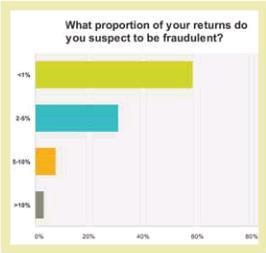ALTHOUGH SMALL IN SCALE RETURNS THROUGH WARDROBING AND FRAUD CAN HAVE A BIG IMPACT ON BUSINESS SO HOW CAN RETAILERS BETTER IDENTIFY AND TACKLE IT?
In the majority of cases shoppers return product for good reason they’ve over ordered, tried for size, changed their mind or product is not fit for purpose.
However when asked what their biggest challenge was in handling returns 12% of retailers said it was the problem of fraudulent returns. The same percentage also cited fraud as being one of the major drivers behind returns too – that is whether customers taking back stolen goods or returning products once they have served their use.
Vicky Brock, CEO of Clear Returns, says that retailers commonly underestimate fraud. “You get two extreme visions neither of which are backed up by the data. You get the shopfloor ‘everyone is at it view’ and the shopfloor ‘everyone is at it it view’ and the marketing view that ‘hour customers are lovely and don’t do that’. Those views are extreme and inaccurate,” she says.
As a proportion of sales fraudulent returns are a small problem for retailers but significant problem for retailers but a significant problem non the less.
Although over half (58%) of retailers in our survey said that fraudulent returns accounted for less than 1 per cent of their returns nearly a third (31%) said it accounted for between 2 and 5% of their returns. For 8% of retailers fraudulent returns accounted for 5 to 10% of their returns and for 3% of retailers for over 10%. Significantly a quarter of retailers also said that fraudulent returns were an increasing problem.
So what can retailers do? For fashion retailers the problem is particularly rife because of the trend of wardrobing – where customers return products having worn them. At Warehouse digital merchandiser Liam Price says such behaviour is dealt with on a case by case basis although fraud is small part of its returns. “we have a hunch that a minority of our customers are wardrobing and we have procedures in place at our refurbishment centre to ensure that only stock not worn is returned for resale. We have an internal tracking system handled by our customer services team and any repeated suspicious behaviour will be flagged and, again, dealt with on a case by case basis,” he says.
At Debenhams logistics carrier managerVinesh Chauhan says the search is thorough to recognise fraudulently returned goods. “We check for labels being intact and also the itembeing returned. For example with a duvet in a box we will check the duvet is the correct one and not a cheaper brand duvet. We have sysstems to show customers that are prolific fraudsters,” he says.
Fraud can also occur from “friendly fraud” where the customer advises the retailer of failed deliveries or returns.
Boden’s customer service manager Peter Hutton says the behaviour of such customers can be almost blindingly obvious. “Quite often someone who is playing the game of missing returns also plays the game of missing items dispatched. You can see a pattern that is quite amazing,” he says.
Hutton says that those that do play the fraud game rarely assume that their purchases or returns are being tracked and can be surprised when a retailer proves a history of fraudulent activity with them. “If you are going to be a fraudster and lie you have to have a good memory,” he says.
Research from Clear Returns suggests in the fashion retail industry a typical wardrober sends back more than 20 items a year. Its ECHO management tool therefore helps to flag up such activity analysing behaviour around returns which then allows the retailer to take preventative action – such as the ability to refuse to fulfil the order in the first place or to to refuse the return. “We try to make sure we empower the retailer – ensure they are Lizright with a back story of data to know they are dealing with returns fraud,” says Brock.
Jonathan Smith, general manager of returns iForce says dataand tracking is extremely extremely important in reducing returns fraud. “We say to the client returns are a customer opportunity and not a logistical or fraud challenge. We are using our reverse logistics data reporting to remove the fraud issue. It’s all about traceability and the data flow and we have developed systems that give clients that type of data,” says Smith.






